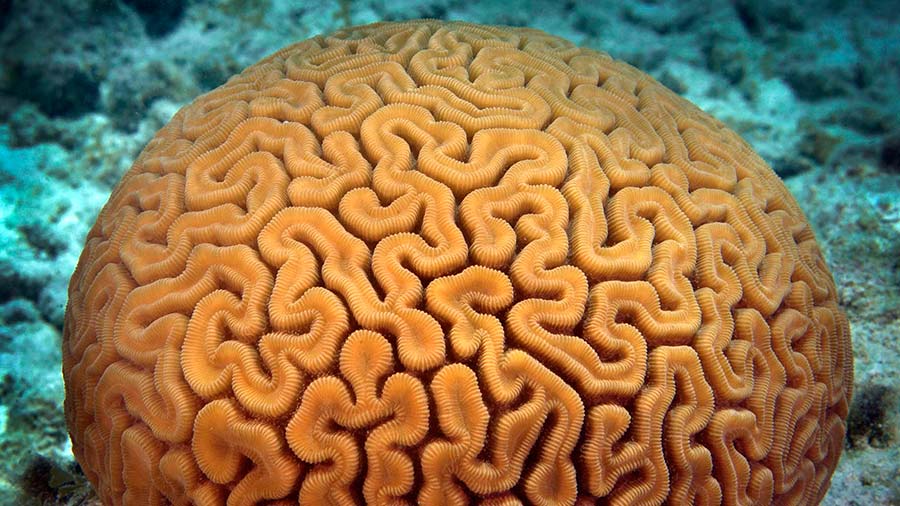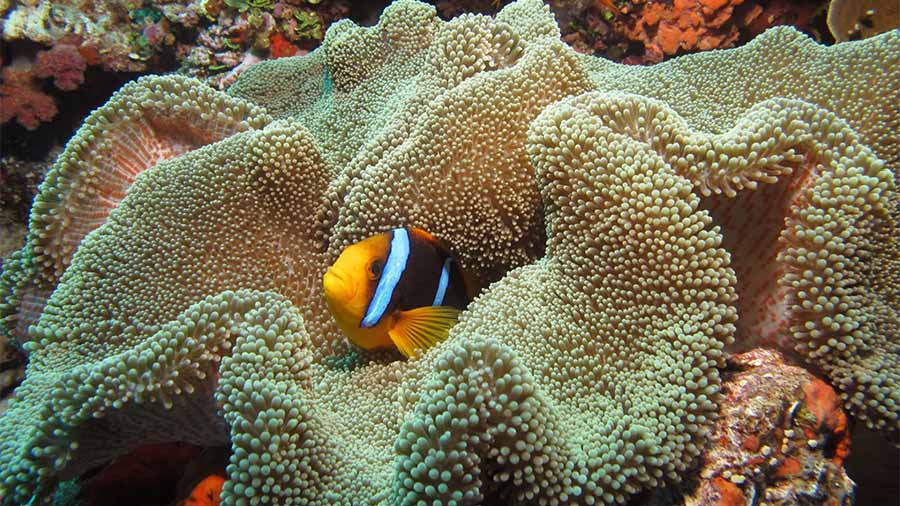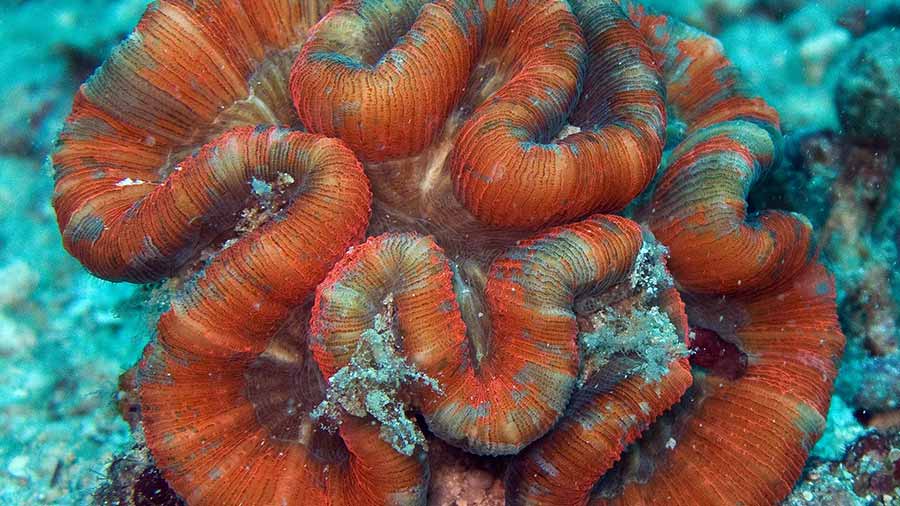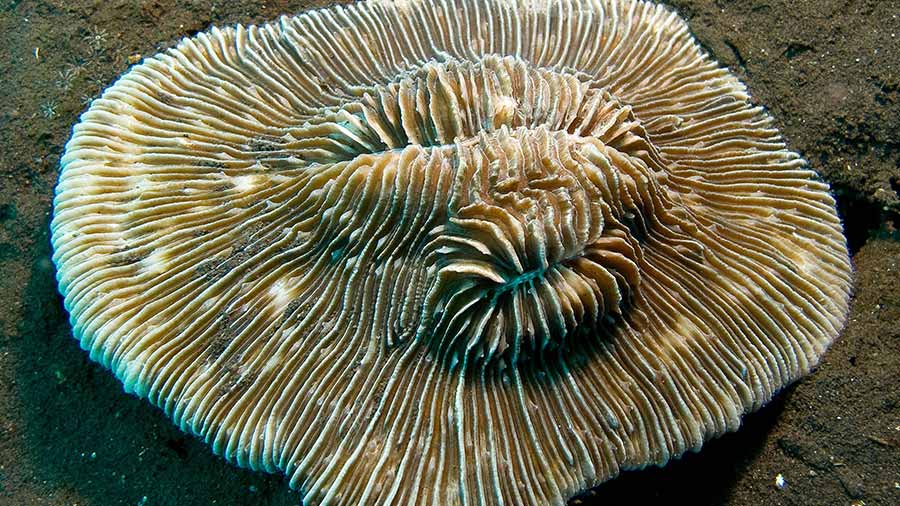From delicate soft corals to reef-building hard corals, here are 17 different types of coral species that are simply breathtaking.
 Staghorn coral provides a sheltered home to a vast array of aquarium/52-marine-animals.html">marine animals | image Albert Kok
Staghorn coral provides a sheltered home to a vast array of aquarium/52-marine-animals.html">marine animals | image Albert Kok
Staghorn coral is one of the fastest growing and most important types of coral species in a coral reef ecosystem. These reef-building hard corals have contributed greatly in establishing the reefs of the world today.
Its common name "staghorn coral" was given due to its resemblance to male deer antlers. Easily recognised by its pointed, textured branches which form dense coral gardens.
Usually found in shallow waters, however, this unfortunately presents a significant threat to the species, as it's badly effected by coral bleaching from global warming.
| Scientific Name | Acropora cervicornis |
| Common Name | Staghorn coral, antler coral, table coral, acropora formosa |
| Type | Hard coral, branching |
| Size (Max) | Height: 4 ft (1.2 m), Diameter: 8 ft (2.4 m) |
| Habitat (Depth Range) | 15-60 ft (4.6-18 m) |
| Conservation Status | Critically Endangered |
 Lettuce leaf coral is also referred to as cabbage coral, plate coral or vase coral | image Carra Oneal
Lettuce leaf coral is also referred to as cabbage coral, plate coral or vase coral | image Carra Oneal
Lettuce leaf coral grows upwards in an unusual conical shape, and their giant ruffled edges make them look like big cabbages. They feed on plankton and are most commonly found in muted colours such as yellow, green and brown.
Their large plate-like structures offers a sheltered habitat for a wide variety of marine life to hide away from predators.
These stony reef-building corals grow in colonies across the Indo-Pacific and thrive in shallow coral reefs in depths of up to 20 metres.
| Scientific Name | Agaricia agaricites |
| Common Name | Lettuce leaf coral, leaf coral, cabbage coral, vase coral |
| Type | Hard coral, branching |
| Size (Max) | Diameter: 3 ft (0.9 m) |
| Habitat (Depth Range) | 15-245 ft (5-75 m) |
| Conservation Status | Least Concern |
 The shape of the elkhorn coral is reminiscent of antlers | image David E Guggenheim
The shape of the elkhorn coral is reminiscent of antlers | image David E Guggenheim
The elkhorn has to be one of the most striking types of coral reef species. Its spectacular antler-like features stand out from other types of coral reef species, and are an impressive sight for any snorkeler or diver.
This stony reef-building coral was once considered one of the most abundant corals found on coral reef eco systems throughout the Caribbean. However, the elkhorn coral is now a critically endangered species due to global warming and coral bleaching.
| Scientific Name | Acropora palmata |
| Common Name | Elkhorn coral, antler coral, table coral |
| Type | Hard coral, branching |
| Size (Max) | Height: 6 ft (1.8 m), Diameter: 12 ft (3.7 m) |
| Habitat (Depth Range) | 3-65 ft (1-20 m) |
| Conservation Status | Critically Endangered |
 Carnation corals are an underwater photographers favourite!
Carnation corals are an underwater photographers favourite!
The stunning carnation coral species, or "Dendronephthya" can be found on coral reefs around the Red Sea, Indian Ocean and the Western Pacific.
Carnation coral thrives in areas with strong current, and usually grow on walls or underneath rocky overhangs. When the current is running, these corals expand and bloom to feed, but when there is no current, they droop down.
Their branch-like stems are pearly white, while their carnation-flower shaped heads come in pink, red, orange and yellow. This range of vibrant shades make the carnation one of the most eye-catching and photogenic types of coral reef species.
| Scientific Name | Dendronephthya |
| Common Name | Carnation coral, tree coral, cauliflower coral |
| Type | Soft coral, branching |
| Size (Max) | Diameter: 2.5 ft (0.8 m) |
| Habitat (Depth Range) | 33-165 ft (10-50 m) |
| Conservation Status | Unknown |
 Bubble corals are often mistaken for fish eggs | image Simon Ilett
Bubble corals are often mistaken for fish eggs | image Simon Ilett
Bubble coral, or Plerogyra sinuosa are one of the most intriguing types of coral reef species. Commonly found in sheltered areas at depths of 3-35 meters, the bubble coral is often mistaken for fish eggs.
During the day, these white/skin coloured polyps resemble bubbles or even a bunch of grapes, but at night the little balloons deflate, allowing for their tentacles to protract and hunt for food.
Bubble corals can be found in coral reef locations such as the Red Sea and Indian Ocean to the mid-Pacific.
| Scientific Name | Plerogyra sinuosa |
| Common Name | Bubble coral, bladder coral, pearl coral, grape coral |
| Type | Hard coral |
| Size (Max) | Diameter: 3.3 ft (1 m) |
| Habitat (Depth Range) | 10-115 ft (3-35 m) |
| Conservation Status | Near Threatened |
 The gorgonian sea fan is a delicate coral reef species.
The gorgonian sea fan is a delicate coral reef species.
One of the most elegant types of coral reef species, is the gorgonian sea fan. Found predominantly in the Bahamas and the West Indies, this beautiful soft coral is made up of an intricate network of branchlets which grow from a small base.
The gorgonian sea fan coral comes in shades of off-white, yellow and lavender and is famously home to the pygmy seahorse, who live their entire adult lives attached to this delicately branched coral.
Their preferred habitat is shallow waters with strong waves at a maximum depth of 10 metres, making them a coral reef species that can be enjoyed by both snorkelers and divers alike.
| Scientific Name | Gorgonia flabellum |
| Common Name | Gorgonian sea fan coral, venus sea fan, West Indian sea fan |
| Type | Soft coral, branching |
| Size (Max) | Height: 5 ft (1.5 m) |
| Habitat (Depth Range) | 10-100 ft (3-30 m) |
| Conservation Status | Unknown |
 The sea whip is part of the beautiful gorgonian soft coral family.
The sea whip is part of the beautiful gorgonian soft coral family.
The svelte whip-like branches of the sea whip coral come in a range of eye-catching colours including red, orange, yellow and purple.
This coral reef species are usually found in deeper waters, living on walls and rocks, growing up to 3 feet.
If you are a keen macro spotter, look out for the minuscule whip coral shrimp, which reside on the branches of this coral reef species.
| Scientific Name | Leptogorgia virgulata |
| Common Name | Sea whip coral, colorful sea whip |
| Type | Soft coral |
| Size (Max) | Height: 3.3 ft (1 m) |
| Habitat (Depth Range) | 6-195 ft (1.8-60 m) |
| Conservation Status | Unknown |
 The sun coral is one of the most sought-after corals for underwater photographers.
The sun coral is one of the most sought-after corals for underwater photographers.
Sun corals, or Tubastaea thrive in coral reef locations across the Red Sea, Indo-Pacific, Western Indian Ocean and the Southern Pacific. They usually live underneath dark overhangs and inside caves where there are nutrient-rich waters and strong currents.
During feeding, the tentacles of this coral will extend from their tubular base and fully open, ready to receive plankton.
These cheerful organisms can be found in an array of bright colours ranging from shades of yellow, orange, red and pink.
| Scientific Name | Tubastraea |
| Common Name | Sun coral, sun polyps, tube coral |
| Type | Soft coral |
| Size (Max) | Diameter: 5.5 inches (14 cm) |
| Habitat (Depth Range) | 0-360 ft (0-110 m). |
| Conservation Status | Endangered |
 The soft organic form of the fox coral make them one of the prettiest types of coral reef species.
The soft organic form of the fox coral make them one of the prettiest types of coral reef species.
Fox corals, also known as jasmine coral or Nemenzophyllia turbida, are one of the most attractive coral reef species. These ruffled polyps range in colour, from light pink through to greeny blue hues.
You will find fox corals living on sheltered coral reefs and underneath rocky overhangs for protection.
Although they are not classed as a species under threat, the fox coral is still relatively rare in the wild and usually reside in coral reefs around the Indo-West Pacific from the Philippines to Papua New Guinea.
| Scientific Name | Nemenzophyllia turbida |
| Common Name | Fox coral, jasmine coral, ridge coral |
| Type | Soft coral |
| Size (Max) | Diameter: 3 ft (1 m) |
| Habitat (Depth Range) | 25-100 ft (8-30 m) |
| Conservation Status | Unknown |
 Each tube of the organ pipe coral has 8 individual tentacles.
Each tube of the organ pipe coral has 8 individual tentacles.
The organ pipe coral, or Tubipora musica is a species that is perhaps better appreciated in person.
They live in the tropical waters of coral reefs in the Indian and Pacific oceans, and generally prefer sheltered areas in shallow waters.
Although this coral reef species is classed as a soft coral, they have a hard skeleton which houses each individual soft tube. Every one of these tubes has a feathery head of tentacles, which are used to feed on plankton. Watch in awe as these mesmerising tentacles open and close in unison.
| Scientific Name | Nemenzophyllia turbida |
| Common Name | Organ pipe coral, pipe organ coral |
| Type | Soft coral |
| Size (Max) | Diameter: 10 ft (3 m) |
| Habitat (Depth Range) | 6-65 ft (2-20 m) |
| Conservation Status | Near Threatened |
 It's easy to see how this species got its common name.
It's easy to see how this species got its common name.
The grooved brain coral received its common name from its remarkably similar appearance to a human brain. Its deep grooves and intricate folding patterns also resemble that of a maze or labyrinth, contributing to its scientific name, Diploria labryinthiformis.
Although this species of reef-building coral appear to be very large, only the outer few millimeters represent living tissue. Grooved brain coral structures only grow a few millimeters each year and many large corals will be hundreds of years old.
This species needs to be at depths where light can penetrate the water, and therefore is most commonly found on reefs at depths between 1 and 30 meters. At these depths the grooved brain coral is often colored brown or yellow. However, in deeper waters, it can have a grayish appearance.
| Scientific Name | Diploria labyrinthiformis |
| Common Name | Grooved brain coral |
| Type | Hard coral |
| Size (Max) | Diameter: 6 ft (2 m) |
| Habitat (Depth Range) | 3-165 ft (1-50 m) |
| Conservation Status | Least Concern |
 Thinner lobes are one way to separate this species from other porites.
Thinner lobes are one way to separate this species from other porites.
Branched finger coral is known to be one of the oldest forms of life on earth due to the slow growth rate of the coral. Many scientist believe that some corals of this species are up to 1,000 years old. Generally found on shallow to mid-slope reef environments, they can also be found among seagrass and on the roots of mangroves.
The common name was received from their appearance. Short, slender lobes/branches with rounded tips, often densely packed together, give the impression of human fingers. The colour of this coral is yellow or grey-brown and the interior parts of the coral often have a purplish tinge.
Branched finger coral, Porites furcata, can be distinguished from other members of the genus 'Porites' with a more uniform lobe size and rounded bulbous lobe tips. The lobes grow to a diameter of up to 0.4 to 0.8 in (1 to 2 cm).
| Scientific Name | Porites furcata |
| Common Name | Branched finger coral, hump coral or finger coral |
| Type | Hard coral, branching |
| Size (Max) | Diameter: 16.5 ft (5 m) |
| Habitat (Depth Range) | 3-66 ft (1-20 m) |
| Conservation Status | Least Concern |
 Bubble tip anemone is one of the larger sea anemones.
Bubble tip anemone is one of the larger sea anemones.
This coral species is known as the bubble tip anemone because of its distinctive bulbous tips at the ends of their tentacles. They are known to host several species of clownfish readily, cleaner shrimp, and porcelain crabs.
The tips of the anemones will have their characteristic bulbs based on several parameters, including; flow, light, bacterial count, color, and which creature it's hosting. Some varieties have larger bulbs than others.
Nutrients are generally obtained by filter feeding using its sweeping tentacles, usually 4-6 cm long, or through wastes and debris cleaned from the surface of its partner anemonefish. Unfortunately, this beautiful anemone is collected for the live aquarium trade.
| Scientific Name | Entacmaea quadricolor |
| Common Name | Bubble tip anemone, rose bubble anemone, bulb tip anemone, bulb tentacle anemone |
| Type | Soft coral |
| Size (Max) | Diameter: 12 in (30 cm) |
| Habitat (Depth Range) | 0-130 ft (0-40 m) |
| Conservation Status | Least Concern |
 Easily recognized by its girthy beige flowing tentacles with pinkish to purple tips.
Easily recognized by its girthy beige flowing tentacles with pinkish to purple tips.
Pink-tipped anemones received its common name from the pink tips at the very ends of their tentacles.
This species can easily be seen growing in lagoons or in inner reefs as either individuals or loose groups, but never as colonies. They are usually found attached to hard objects in shallower waters and often pair up with cleaner shrimp and porcelain crabs.
They combine a hardy nature with natural beauty and have a powerful sting designed for taking out fish that come too close. It also feeds upon fish, mussels, shrimp, zooplankton, and sea worms.
| Scientific Name | Condylactis gigantea |
| Common Name | Pink-tipped anemone, condy anemone, giant Caribbean anemone, giant golden anemone |
| Type | Soft coral |
| Size (Max) | Diameter: 20 in (51 cm) |
| Habitat (Depth Range) | 0-90 ft (0-30 m) |
| Conservation Status | Least Concern |
 A saddle carpet anemone is host to a clownfish.
A saddle carpet anemone is host to a clownfish.
One of the most colorful of the clown-hosting anemones. Saddle carpet anemones come in sandy shades of brown to greens, blues, and purple, and are hosts to seven different clownfish species.
Saddle carpet anemones can be easily differentiated from other anemones with their short, bulbous and sticky tentacles. They have a large oral disc with folds that are somewhat closely spaced, which can give it a wavy carpet appearance.
They have stinging cells that line their tentacles and are carnivorous like many other sea anemones, feeding on various invertebrates and capture food particles that are suspended in water for ingestion.
This species is mostly found singly on reefs and soft sandy bottoms and often rooting themselves into the substrate, they usually do not move around but have the capability to.
| Scientific Name | Stichodactyla haddoni |
| Common Name | Saddle carpet anemone, Haddon’s carpet anemone, saddle anemone |
| Type | Soft coral |
| Size (Max) | Diameter: 2.5 ft (0.75 m) |
| Habitat (Depth Range) | 13-130 ft (4-40 m) |
| Conservation Status | Least Concern |
 A brightly colored folds resemble a cabbage or human brain.
A brightly colored folds resemble a cabbage or human brain.
Open brain coral is a free living and vibrantly colored species that is found mainly in the Indo-Pacific oceanic area. This species can be found in a wide range of environments but usually live fairly deep for corals.
These corals are hourglass shaped or highly lobed and usually colored in very intense color variations, either multicolour or monochromatic, in pretty much the entire color of the rainbow. For a psychedelic experience, shine a UV torch on them and watch these corals light up.
They are relatively small corals, rarely reaching over 20 cm in diameter and are known to host a species of Gall crab. Open brain corals are under threat from over-harvesting for the aquarium trade, habitat loss and global warming.
| Scientific Name | Trachyphyllia geoffroyi |
| Common Names | Open brain coral, folded brain coral, cabbage coral, banana coral |
| Type | Hard coral |
| Size (Max) | Diameter: 8 in (20 cm) |
| Habitat (Depth Range) | 100-130 ft (30 - 40 m) |
| Conservation Status | Near Threatened |
 Mushroom-like, with rows of tiny spines and a color than is usually brown.
Mushroom-like, with rows of tiny spines and a color than is usually brown.
Mushroom coral is commonly found throughout the world's oceans, usually on upper reef sleep with fast movement of water. Most live in tropical waters, but there are also variants of this species that thrive in cold water.
Unlike most corals, mushroom coral are a solitary species and live loose on the seafloor, they are attached to the reef only when they are small.
The common name for this species was given for its dense oval shape and the radiating skeletal walls (septa) that give this coral its mushroom-like appearance.
| Scientific Name | Pleuractis paumotensis |
| Common Name | Mushroom coral, plate coral, razor coral, fungia paumotensis |
| Type | Hard coral |
| Size (Max) | Diameter: 10 inches (25 cm) |
| Habitat (Depth Range) | 0-130 ft (0-40 m) |
| Conservation Status | Least Concern |
There are about six thousand species of coral around the world. These can be broken down into two groups – hard and soft.
Every coral species is made up of hundreds to thousands of polyps, they are tiny and usually no greater in diameter than half an inch.
The difference between hard and soft corals can be determined by checking the number of tentacles each polyp has.
Hard coral polyps have multiples of six tentacles.
As the name suggest, hard corals look rigid as their polyps form hard, calcium carbonate skeletons.
There are around 800 known species of hard coral, also known as the 'reef building' corals.
Soft coral polyps always have eight tentacles.
Soft corals often appear like brightly colored plants, they have a distinctive feathery appearance and do not have a rigid stony skeleton.
Soft corals are not involved in reef-building since they do not produce the hard calcified skeleton necessary.
animal tags: coral
We created this article in conjunction with AI technology, then made sure it was fact-checked and edited by a Animals Top editor.